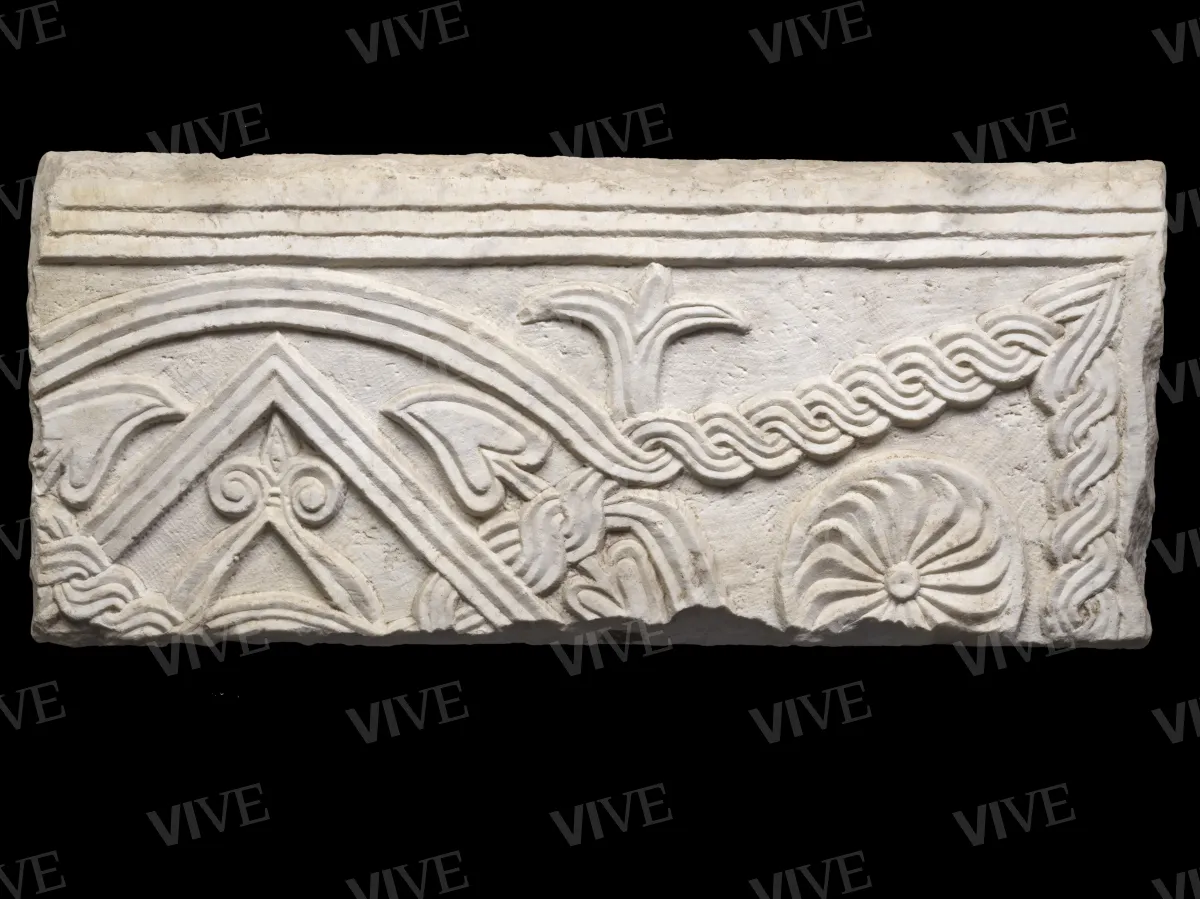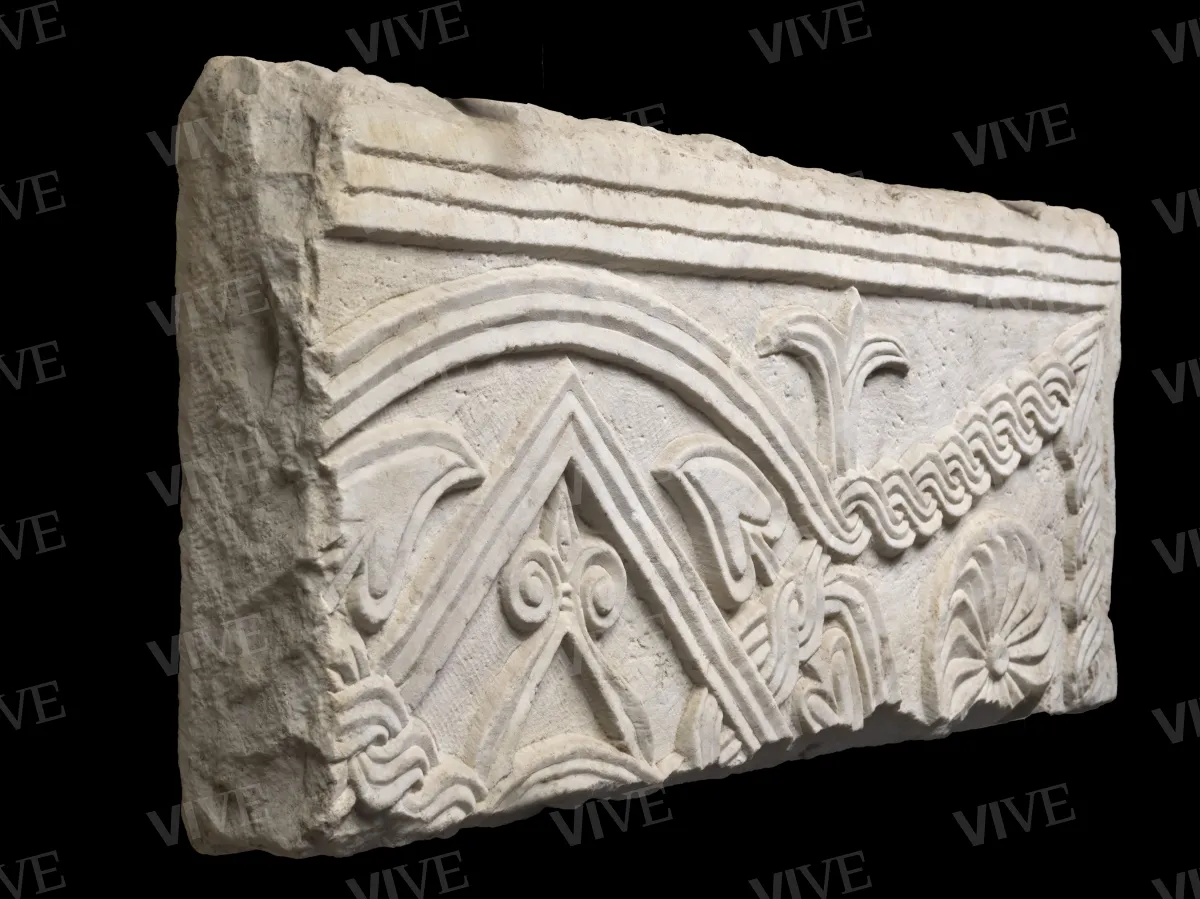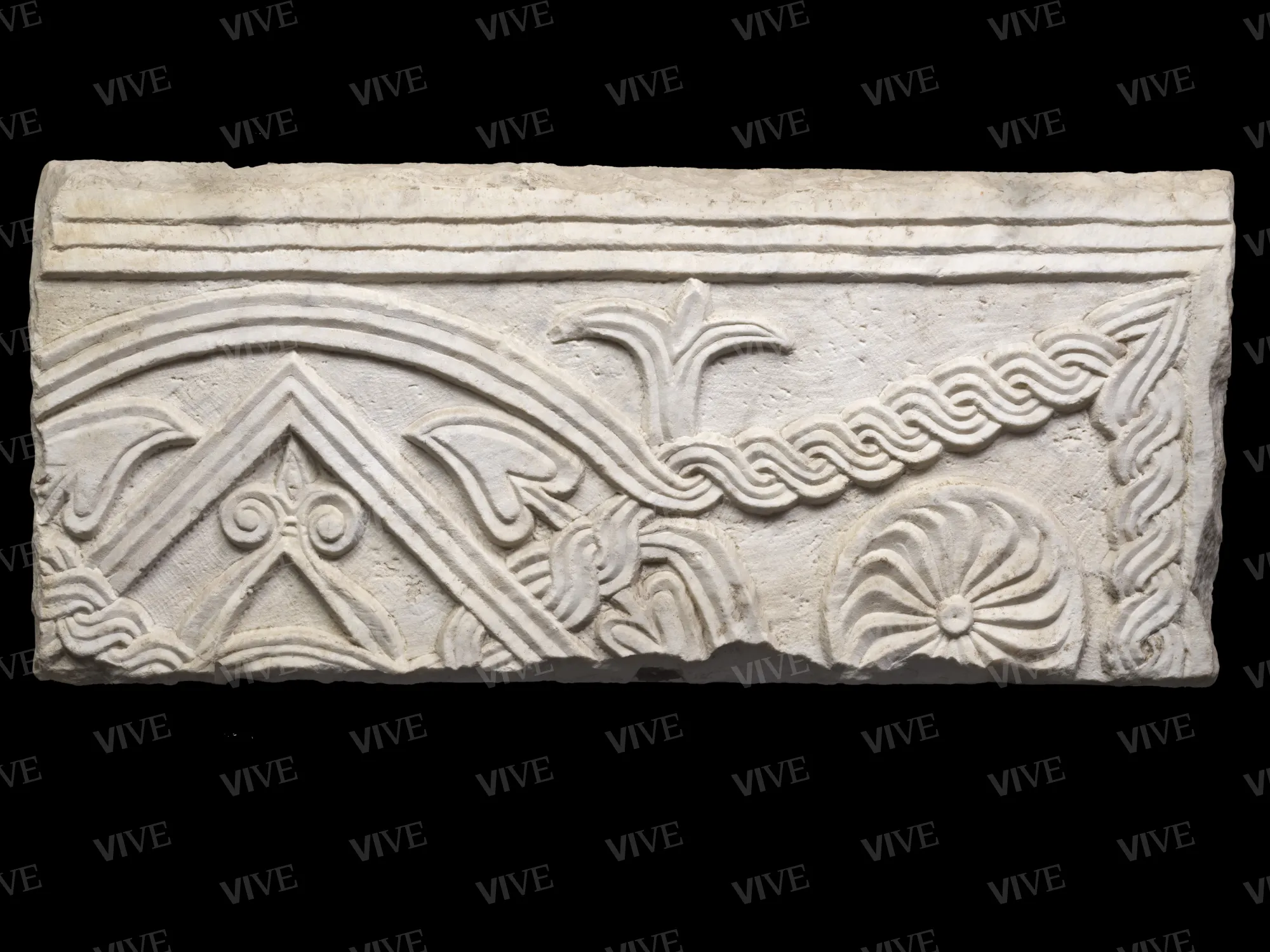Fragment of pluteus with Korbboden motif
Roman milieu First three decades of 9th century
Fragment of a marble pluteus decorated with a Korbboden motif, consisting of a lozenge inscribed within a circle of two-lined wicker ribbon knotted in a braid cutting diagonally across the slab and joining at right angles with another braid tangential to the frame, delimiting a triangular space filled with a rotating rosette. From the knot arise a fleur-de-lis on the outside and two profiled heart-shaped leaves on the inside, facing opposite directions. The lozenge is covered by a small circle of bisected wicker ribbon on which a fleur-de-lis form is set in an aeolian capital.
Fragment of a marble pluteus decorated with a Korbboden motif, consisting of a lozenge inscribed within a circle of two-lined wicker ribbon knotted in a braid cutting diagonally across the slab and joining at right angles with another braid tangential to the frame, delimiting a triangular space filled with a rotating rosette. From the knot arise a fleur-de-lis on the outside and two profiled heart-shaped leaves on the inside, facing opposite directions. The lozenge is covered by a small circle of bisected wicker ribbon on which a fleur-de-lis form is set in an aeolian capital.
Details of work
Catalog entry
This fragment of a marble pluteus, of which only the upper right section bordered by a sawtooth frame is extant, is decorated with a motif technically known as Korbboden (Kautzsch 1939, given as circle-rosette-cross in Roth-Rubi 2018, Exkurs 3)—that is, a circle spanned by a rosette, from which a diagonal interlaced cross develops, which joins a larger circle including a lozenge and phytomorphic motifs (on this motif, see, among others, Ibsen 2008; Betti 2017). This simple decorative scheme is declined in different, ingenious ways on Carolingian liturgical furnishings of the first half of the ninth century and is particularly prevalent in the second decade (occurrences listed in Roth-Rubi 2018).
It is a symbolic, deeply significant form that is no longer linked to the natural forms of the “basket base” and is instead used to introduce “intellectual discourse” (Romanini 1975) and a new “rational” and “humanistic” language (Casartelli Novelli 1976), the result of a cultural restoration shared between papal Rome and Aachen’s imperial Schola Palatina (Casartelli Novelli 2019). Its meaning is cosmological, a “worldview” and “image of Christological salvation” (Ballardini 2017), bringing together as it does the symbols of eternity and perfection at the center of which is the Christ-rose (Elbern 1983).
In our fragment, the design is still broadly discernible: a double concentric circle of two-lined wicker ribbon, which probably contained a central rosette, is crossed by a guilloche cross running along the diagonal lines of the slab moving to the four corners, where, bending at a sharp angle, it resumes its course on the vertical axis towards the frame. Inscribed within the two concentric circles is a lozenge, also of two-lined wicker ribbon, filled in the gable-like space between the upper apex and the innermost circle by a bifurcated-stemmed lily form, known as an aeolian capital (Seminario 1976). The ensuing spaces beyond the lozenge and included in the greater circle are filled by a pair of heart-shaped leaflets, extending from the node connecting the two concentric circles and facing opposite directions. A large, beveled-ribbon fleur-de-lis, tangential to the frame, and a rotating rosette with a central raised button occupy the remaining intervals beyond the largest circle.
The artifact is technically and formally sophisticated; the background is carefully lowered so as to offer, even in the crowding of decorative motifs, a clear reflective plane. The circle and lozenge are clearly outlined and regular in proportion and carving, and the circumference of the circle and rosette are both undertaken with some degree of perfection.
This iconography is attested to in the Roman area from as early as the late eighth century (according to Kautzsch 1939, one of the earliest examples is the pluteus from the church of San Silvestro at Sant’Oreste al Soratte, Raspi Serra 1974, fig. 142, now dated by Ibsen 2008 to the late-ninth century and by Roth-Rubi 2018 to the second or third decade of the ninth century), and was fully established by the first half of the ninth century, when we find extremely refined examples, such as the pluteus of Santa Sabina (Mazzanti 1896; Trinci Cecchelli 1976, fig. 246) from the period of Eugene II (824–827).
The detail of the braid folded at a 45-degree angle along the frame reappears in the fragment of a pluteus from Santa Prassede (Pani Ermini 1974, fig. 62) which belongs to the presbyterial enclosure of Paschal I (817–824). However, this relic is very similar to, and therefore potential coeval with, a double-sided pluteus from the enclosure of Santa Sabina (Trinci Cecchelli 1976, fig. 246), which has been dated to the time of Eugene II (824–827), which it also resembles in terms of the overall formal detail and compositional balance.
It is conceivable that the slab was part of a system with the iconographic motif of the circle–rhombus–cross which is associated with the vegetal shoot of opposing polylobate leaf whorls, present in the form of a double fragment in the Palazzo Venezia Lapidarium (inv. 13597), similarly to reconstructions of other liturgical furnishings from the early ninth century (Roth-Rubi 2015; Roth-Rubi 2018; Roth-Rubi 2020). Our sherds can be seen as parts of the same pluteus in terms of thickness (8.5 and 8.9 cm) and material, which is also apparent when compared with the more stylistically related examples recalled above. In terms of meaning, the idea of perfection within the Christian cosmos, which has at its center the symbolic image of the Messiah and is conveyed by the iconography of the circle–rhombus–cross, is superimposed by the idea of paradisiacal bliss, recalled by the vegetal shoot that is a figure of the arbor vitae.
Valentina Brancone
Entry published on 12 February 2025
State of conservation
Fair. Cropped and chiseled.
Restorations and analyses
2002–2003 (restoration directed by Maria Giulia Barberini and Maria Selene Sconci, undertaken on the occasion of the founding of the Museo di Palazzo Venezia Lapidarium).
Provenance
Unknown. Found during excavations for the Palazzetto, as part of demolition carried out in the area for the relocation of the Palazzetto di Venezia (1910–1914).
Sources and documents
Rome, Archivi fotografici, Palazzo Venezia Museum, Foto Guidotti, no. 4151 (1960s);
Rome, Archivio del Museo del Palazzo di Venezia, inventorying the sculptures of the lower and upper loggias (manuscript inventory edited by Maria Vittoria Brugnoli, 1973);
Seminario sulla tecnica e il linguaggio della scultura a Roma tra VIII e IX secolo, in Atti del simposio su Roma e l'Età carolingia, coordinated by Avagnina Maria Elisa, Institute of Archaeology and Art History, Rome 1976.
References
Mazzanti Federico, La scultura ornamentale romana nei bassi tempi, in «Archivio Storico dell’Arte», s. II, II, 1896, pp. 33-57, 161-187;
Kautzsch Rudolf, Die römische Schmuckkunst in Stein vom 6. bis zum 10 Jahrhundert, in «Römisches Jahrbuch für Kunstgeschichte», III, 1939, pp. 3-73;
Pani Ermini Letizia, La Diocesi di Roma, t. I, La IV regione ecclesiastica, Corpus della scultura altomedievale, VII, Spoleto 1974;
Raspi Serra Joselita, La Diocesi dell’Alto Lazio. Bagnoregio, Bomarzo, Castro, Civita Castellana, Nepi, Orte, Sutri, Tuscania, Corpus della scultura altomedievale VIII, Spoleto 1974;
Romanini Angiola Maria, Tradizione e «mutazioni» nella cultura figurativa precarolingia, in La cultura antica nell’Occidente latino dal VII all’XI secolo, XXII Settimana di studio del CISAM, Spoleto 1975, pp. 759-789;
Casartelli Novelli Silvana, L’intreccio geometrico del IX secolo, scultura delle cattedrali riformate e «forma simbolica» della rinascenza carolingia, in Istituto di Storia dell’Arte dell’Università di Roma (a cura di), Roma e l’età carolingia. Atti delle giornate di studio (Roma, 3-8 maggio 1976), Roma 1976, pp. 103-113;
Trinci Cecchelli Margherita, La Diocesi di Roma, t. IV, La I regione ecclesiastica, Corpus della scultura altomedievale, VII, Spoleto 1976;
Elbern Victor Heinrich, Bildstruktur-Sinnzeichen-Bildaussage. Zusammenfassende Studie zur unfigürlichen Ikonographie im frühen Mittelalter, in «Arte medievale», 1, 1983, pp. 17-37;
Latini Massimo, Sculture altomedievali inedite del Museo Nazionale del Palazzo di Venezia in Roma, in «Rivista dell’Istituto Nazionale d’Archeologia e Storia dell’Arte», 57, 2003, pp. 113-152;
Ibsen Monica, L’arredo liturgico di Maguzzano. Contesti locali, irradiazioni sovraregionali, migrazioni, in Brogiolo Gian Pietro, Chavarría Arnau Alexandra, Ibsen Monica, Maguzzano (Lonato-Brescia) e la sua dipendenza di Soiano: da fondazione privata a monastero del vescovo di Verona, in «Archeologia Veneta», XXIX-XXX (2006-2007), 2008, pp. 167-205;
Roth-Rubi Katrin (in collaborazione con Sennhauser Rudolph), Die frühe Marmorskulptur aus dem Kloster St. Johann in Müstair, Ostfildern 2015;
Ballardini Antonella, Scultura in pezzi: appunti sulla scultura altomedievale di Santa Prassede, in «Summa», 9, 2017, pp. 5-28;
Betti Fabio, L’arredo liturgico della Basilica di Santa Sabina al tempo di papa Eugenio II: dalla scoperta ai restauri storici (1894, 1918, 1936), in «Arte medievale», 7, 2017, pp. 31-52;
Roth-Rubi Katrin, Die frühe Marmorskulptur von Chur, Schänis und dem Vinschgau (Mals, Glurns, Kortsch, Göflan, Burgeis und Schloss Tirol), Ostfildern 2018;
Casartelli Novelli Silvana, Decoro a "Korbboden" (fondo di canestro): una nota sul «vizio di noi occidentali, della spiegazione mimetica delle immagini, anche in presenza di disegni astratti», in «Arte medievale», 9, 2019, pp. 9-58;
Roth-Rubi Katrin, La scultura nella Rezia, il suo legame con l’Italia e il Rinascimento carolingio, in Ammirati Serena, Ballardini Antonella, Bordi Giulia (a cura di), Grata più delle stelle. Pasquale I (817-824) e la Roma del suo tempo, vol. 2, Roma 2020, pp. 111-127.














